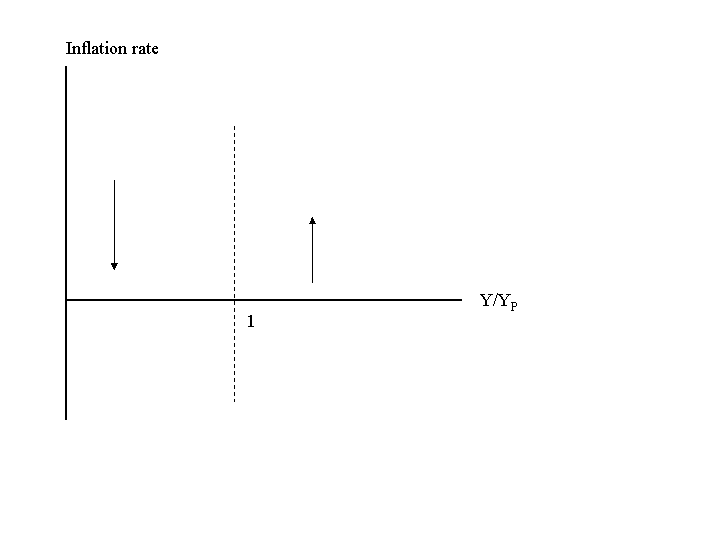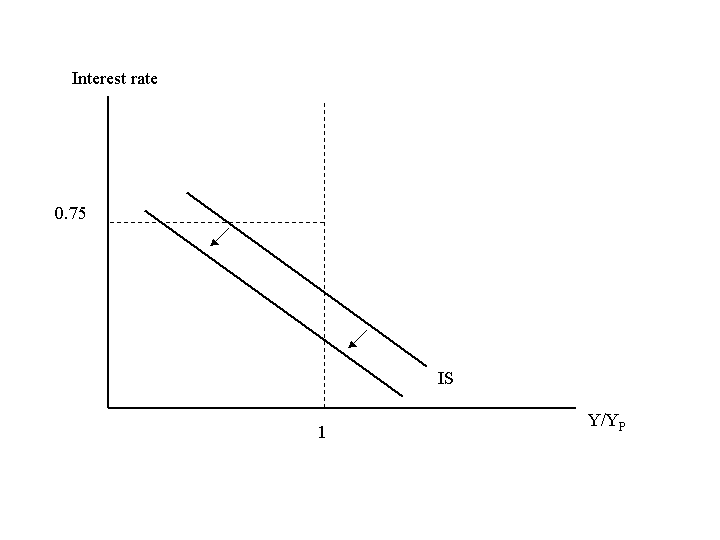
SYNOPSIS: Krugman incorporates deflation into the previous macro model. This piece is a companion to this one and this one and this one, and the three address some critics' false accusations of arithmetic problems in his 4.22.03 NYT piece.
Well, whaddya know - my little seminar on liquidity traps, fiscal policy, and jobs seems to have cleared the air. (There are some people who would accuse me of lying if I said that grass is green, but there's nothing to be done about that.) In any case, I now think that it might be useful to use the same framework to explain my view of the issues surrounding our so-called recovery, and the related issue of deflation.
My starting point here is to remind people of the concept of potential
output. This is the maximum level of output consistent with a stable inflation
rate. Standard textbook macro tells us that if output exceeds potential,
the inflation rate will rise; if output is below potential, the inflation
rate will fall. So the situation looks like this:

The important point here is that potential output YP rises over time; if productivity rises 2.5 percent per year and the potential work force rises 1 percent per year, potential output rises 3.5 percent per year. Growth slower than that means a falling ratio of actual to potential output, so you move to the left in this figure.
Why does the inflation rate matter? For current purposes I'm interested in the effect on demand. That effect in turn can be divided into two parts. Unexpected inflation has wealth/balance sheet effects; most famously, large unexpected deflation can wreak havoc with firms' balance sheets, leading to Irving Fisher's debt deflation story. That's not a scenario we're worried about right now. But expected inflation shifts the IS curve, since rational investors look at the real rather than the nominal interest rate.
Suppose that the real interest rate consistent with output equal to potential is 2 percent. Then if the expected inflation rate is zero, the required nominal rate will be 2, but if expected inflation is 2, the required nominal rate will be 4:

Now for the reasons to be concerned. Suppose that for whatever reason
we find ourselves operating below potential output, despite an interest
rate as low as it can go. (As mentioned before, the Fed seems to think
that 0.75 is a lower bound.) So the situation looks like this:

Now this situation isn't stable. Other things equal, the fact that
output is below potential will lead to a declining rate of inflation. As
this disinflation gets reflected in expectations, the IS curve will shift
down:

This will worsen the output gap, leading to even lower inflation, and
so on.
Now there are a lot of things besides expected inflation that shift the IS curve. The conventional wisdom is that a bounceback in investment demand will bring us comfortably out of the liquidity trap, any day now. I'm not so sure. But in any case my point is analytical: the thing to worry about is a spiral of declining output relative to potential and declining expected inflation.
And now for the punchline: zero is not a significant number, either for growth or inflation.
Suppose that the economy is growing: does that mean that things are getting better? No: as long as growth is slower than potential, Y/YP is falling, not rising, and we're getting deeper in the hole.
Suppose that we don't actually have deflation - major price indexes are still rising, if slowly. Does that mean everything is OK? No - the problem isn't with deflation per se, it's with falling expectations of inflation that make the lower bound on interest rates more binding.
Some people say that the US economy is doing OK - it's growing, if slowly, and we don't have deflation. But as Ahearne et al show in their analysis of Japan, the same was true of Japan between 1992 and 1995: Japan didn't plunge into deflation and a liquidity trap when the bubble burst, it drifted in slowly, with consensus forecasts consistently overpredicting growth and inflation.
For all its brave words, I think the Fed understands all this. But a halfway sensible fiscal policy would really help right ... oh, never mind.
Originally published on the Official Paul Krugman Page, 5.4.03